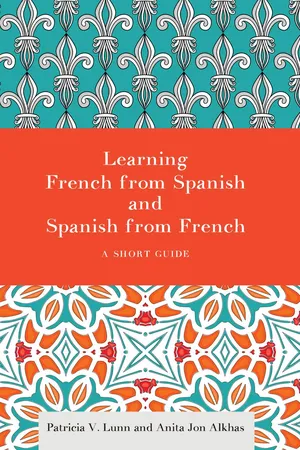
Learning French from Spanish and Spanish from French
A Short Guide
- 156 pages
- English
- ePUB (mobile friendly)
- Available on iOS & Android
About this book
Learning French from Spanish and Spanish from French provides adult English speakers who have learned either Spanish or French as a second language with the tools to learn the other as a third language. Research in the growing fields of third-language acquisition and multilingualism documents how successful language learners intuitively build on their existing knowledge as they learn a new language. In this vein, Learning French from Spanish and Spanish from French takes advantage of the fact that learners with intermediate proficiency in a second language are used to thinking consciously about language, know themselves as language learners, and can capitalize on what they know about one language to understand the other. With chapters conveniently organized by grammatical concept and including supplementary resources such as exercises, parallel reading texts, and audio files, this book will benefit students, travelers, and budding multilinguals alike.
Frequently asked questions
- Essential is ideal for learners and professionals who enjoy exploring a wide range of subjects. Access the Essential Library with 800,000+ trusted titles and best-sellers across business, personal growth, and the humanities. Includes unlimited reading time and Standard Read Aloud voice.
- Complete: Perfect for advanced learners and researchers needing full, unrestricted access. Unlock 1.4M+ books across hundreds of subjects, including academic and specialized titles. The Complete Plan also includes advanced features like Premium Read Aloud and Research Assistant.
Please note we cannot support devices running on iOS 13 and Android 7 or earlier. Learn more about using the app.
Information
Chapter 1
¿CÓMO SE ESCRIBEN LOS SONIDOS?
COMMENT S’ÉCRIVENT LES SONS?
1A. STRESS AND ACCENT MARKS
Comparar/Comparer

Detalles/Détails
Table of contents
- Cover
- Half title
- Title
- Copyright
- Table of Contents
- Preface
- About this Book
- Beyond this Book
- Acknowledgments
- Introduction
- Chapter 1 ¿Cómo se escriben los sonidos?/Comment s’ écrivent les sons?
- Chapter 2 ¿Cómo se clasifican y se describen los sustantivos?/Comment se classifient et se décrivent les noms?
- Chapter 3 ¿Cómo funcionan los pronombres?/Comment s’ emploient les pronoms?
- Chapter 4 ¿Cómo se conjugan y se interpretan los verbos?/Comment se conjuguent et s’ interprètent les verbes?
- Chapter 5 ¿Cómo se estructuran las frases?/Comment se structurent les phrases?
- Chapter 6 ¿Cómo se clasifican las palabras?/Comment se classifient les mots?
- Chapter 7 ¿Cuál es la lengua más difícil?/Quelle langue est la plus difficile?
- Answer Key
- Parallel Texts
- Verb Conjugation Charts
- Glossary